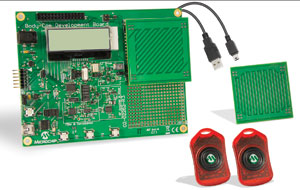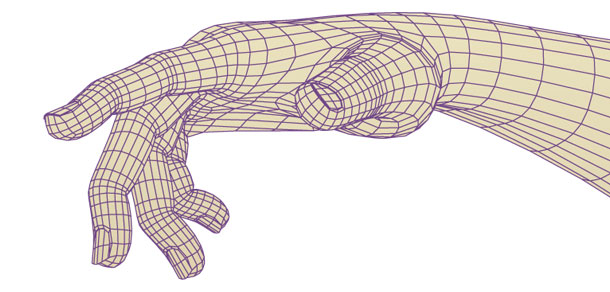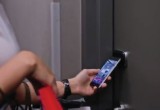Contact, contactless or flesh?
Human body replaces 'wires' to transmit ID data
06 August, 2013
category: Contactless, Corporate
Imagine accessing a secure area or service without fumbling for a card, swiping an ID badge or keying in a PIN. It is possible with new technologies that utilize the human body as the conduit to transmit the identification and authentication data.
Thomas Zimmerman introduced this concept in a 1980 MIT thesis. One of the first technologies to utilize the concept in consumer applications is the BodyCom solution from Microchip Technology. “Fundamentally BodyCom is a short-range, low data rate communication,” says Edward Dias, business development manager for security and authentication products in the MCUE division of Microchip.
But here is where it gets interesting. It uses a coupling pad to charge the human body and a base unit similar to an automobile key fob that the user holds. When the user steps on the coupling pad the body is charged and the keyfob receives the power it needs to start. The fob – which can be kept in the individual’s pocket – is then authenticated and access is granted or denied.
“It’s capacitive coupling like the way you would touch your iPhone or touch a screen,” Dias explains.

BodyCom technology utilizes the human body as the element that transmits the authentication data to a physical access control reader. The BodyCom Development Kit aims to help engineers program, debug, and develop secure communication systems for access control or passive keyless entry.
BodyCom is similar to a passive keyless entry system – those that enable car doors to open without requiring the user to push a button on the fob – but this technology uses less energy because it’s not constantly pumping out an inductive field.
The system uses the same 125-kilohertz technology that is common in proximity card systems for communication from the reader to the keyfob. The keyfob responds back using the eight-megahertz frequency. “We use different frequencies so they’re not colliding with each other. Eight megahertz is common in many of our microcontrollers,” says Dias.
Microchip Technology offers a free software development kit to enabled manufacturers to develop applications to use the BodyCom technology as long as it’s used in conjunction with any of the company’s portfolio of more than 1,000 microcontrollers, explains Dias.
The company uses two forms of technology with this type of system. The first requires a user to physically touch a sensor, says Dias.
The second uses the mobile keyfob and a proximity scheme. “Proximity gives you the ability to take that mobile unit, and put in your pocket, backpack, purse, etc. As long as it is within four or five inches of the body, it’s dialed in,” says Dias.
How the system is being used can determine whether touch or proximity is the technology being employed. Health care is looking at the technology for access to surgical suites where touching anything would be bad.
In this instance, a nurse or doctor would have a fob or card around their neck and the coupling pad could be laid in a floor mat in front of a doorway. “As you walk across the mat, that would actually capacitively couple and do the authentication with the key fob to open up the door. They wouldn’t have to touch anything so it keeps that hospital room sterile,” says Dias.
While Microchip Technology has designed the mobile unit as a key fob, it could come in a variety of forms, such as a typical card-sized badge or a button that hangs from a user’s keychain. “The difference here is it has to be managed by the application because the proximity works in direct correlation to the size of the coupling pad. The larger the coupling pad, the longer distance you would have,” says Dias. “And we see everything from the size of a quarter to a 12×12-inch pad.”
The typical transmission rate for the authentication process on a system that doesn’t have a lot of built-in security is about 100 milliseconds, says Dias. “Once you start layering the rest of the software on there, if you want to increase layers of encryption, then you start increasing the size of the data packet. That will slow it down, but you can also ramp up the microcontroller speed to accommodate that,” says Dias.
The technology could be used in a variety of applications, says Dias, perhaps most commonly as a replacement for passive keyless entry to automobiles. Manufacturers can also potentially use BodyCom technology in home security systems; home or industrial door locks and even as personal safety and security for potentially dangerous items such as firearms or power tools.
Dias gives the example of the technology being used with a battery-powered circular saw. When the owner pulls the trigger he would be authenticated and makes the cut. “I put it down, take my hand off it, turn my back, and I don’t have to worry about my ten-year-old son grabbing the saw and playing with it because he’s not paired up with it. It’s kind of enabling equipment and disabling it at the same time,” says Dias.
Adding the technology to video game controllers could let players can take their controller to their friend’s home, touch the base station and have their own profile added to the system. It can also be used to lock someone out of playing with a user’s system, says Dias.
Pets can also harness BodyCom technology as a means of getting through a pet door in a home. The pet can wear a tag, touch its nose to a pet door and be allowed access. “In Arizona, we have coyotes coming in through pet doors and taking pets. It could keep these unwanted pet criminals away,” says Dias.
Other technologies using the body as the channel
Whether or not BodyCom technology can establish a foothold in the authentication market remains unclear, but similar efforts by other companies have been met with skepticism and have struggled as a result.
Konica Minolta developed its Body Area Network technology for use by companies that require users to log in to photocopy machine and printers in an effort to prevent information leaks. “The requirement of logging in with ID/Password each time is troublesome and time-wasting for users,” says Akiko Kaise, spokesperson for Konica Minolta.
Konica Minolta partnered with Dai Nippon Printing in 2010 to develop the Body Area Network technology. Today it is working with Ad-Sol Nissin, which has a similar technology called Touchtag, to introduce the product into the market, explains Kaise.
Konica Minolta has demonstrated its Body Area Network technology at trade shows as far back as 2010, and it’s continuing to develop this technology. “Almost all customers who saw human body communication authentication responded with surprise to see the actual hands-free authentication,” says Kaise.
Still, manufacturers could face some resistance from consumers who don’t like the idea of electronic currents running through their body.
“You’re never going to get everyone to agree that this is just fine,” says Dias. He believes that there will always be some contingent questioning the effects of this frequency or current going through their body. “Normally they’re asking this question while they have their mobile phone up to their head,” says Dias.
Dias says Microchip does get questions from the medical field on whether or not BodyCom technology would interfere with medical devices like pacemakers. The company has looked into this and compared BodyCom with the passive keyless entry market. “If you look at that application, just by comparison, our application typically would generate on a coupling pad somewhere on the order of 60 volts roughly. In a passive keyless entry system that you have on a variety of different automobiles today, that generates on the order of 600 volts,” says Dias.
Some automotive manufacturers, such as Toyota, that integrate passive keyless entry systems do include warning labels in the car’s user manual for those who wear pacemakers. It will be up to the application developer to design a system that complies with the necessary FDA specifications, says Dias.
Still, that’s not deterring developers from thinking of ways to bring BodyCom technology to the consumer. “When you talk to people, you just see their eyes light up. They start generating ideas of how it could be implemented. I think we’re just touching the surface of potential applications right now,” says Dias.




